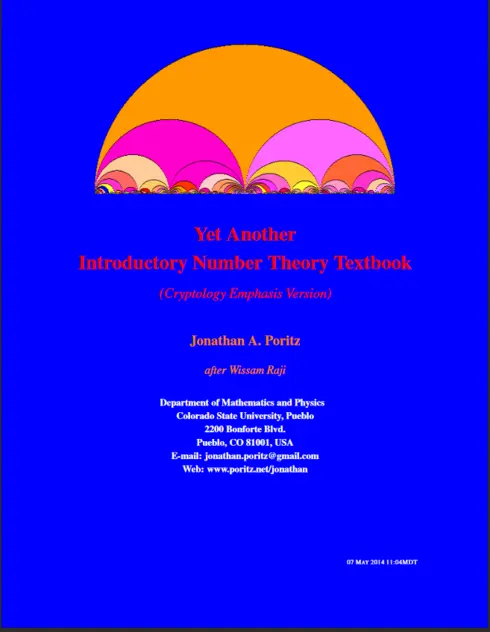
Yet Another Introductory Number Theory Textbook (Cryptology Emphasis Version)
![]()
![]()
![]()
![]()
![]()
Jonathan A. Poritz
Copyright Year:
Publisher: Jonathan Poritz
Language: English
Formats Available
Conditions of Use
![]() Attribution-ShareAlike
Attribution-ShareAlike
CC BY-SA
Reviews
Reviewed by Ben Cote, Assistant Professor, Western Oregon University on 4/19/19
The text does a good job of providing the bare-bones essentials of number theory in the first three chapters. These portions of the text are quite concise, providing a decent outline of the key theorems and definitions without much in the way of... read more
![]()
![]()
![]()
![]()
![]()
Reviewed by Ben Cote, Assistant Professor, Western Oregon University on 4/19/19
Comprehensiveness
The text does a good job of providing the bare-bones essentials of number theory in the first three chapters. These portions of the text are quite concise, providing a decent outline of the key theorems and definitions without much in the way of motivation. The text is much more motivated and developed in the fourth chapter, on cryptology. This is the section of the book that really shines and provides a better reading experience. The fifth chapter returns to more of a concise definition-example-theorem-proof format, which still provides a nice outline for the material covered but does lend itself toward stand-alone reading.
Content Accuracy
In my quick reading I did not notice any glaring errors.
Relevance/Longevity
Since the topic of number theory is quite old, there is little worry that the material will become obsolete any time soon. The crypotology chapter provides a concise history of relevant encryption methods and it would not be difficult to add on sections if desired.
Clarity
Many ideas are presented without much motivation or explanation. For example, the division algorithm is stated as a theorem, proven, and then used in other proofs, but there is no prose discussing its usefulness or motivating the idea in the first place.
Consistency
The terminology appears to be consistent throughout, but the general feel and look of each section varies wildly in terms of amount of prose, number of examples, etc.
Modularity
The chapter on cryptology could easily be assigned as a few readings for a course, but the first few chapters would mostly only serve as reference notes to back up material introduced and deeply motivated elsewhere (i.e. in class).
Organization/Structure/Flow
Topics are presented in a reasonably logical order. However, an additional block of text at the beginning or end of each section/chapter describing where things are heading would be a helpful addition.
Interface
The typesetting is perfectly fine and the (few) images fit well on the pages.
Grammatical Errors
The prose, when there, is written in a very informal tone. In places, this informality causes issues in the grammar and phrasing.
Cultural Relevance
It is difficult to rate this topic, as the text has very few references to people of any sort. One of the few references is a joke about the Babylonian number system: " And apparently the Babylonians had 30 fingers on each hand, or 15 on each hand and each foot, since they used base 60." I think this borders on cultural insensitivity, particularly because one could emphasize the advantages to a base-60 system, and that would provide much more interesting and relevant material than the punchline.
Table of Contents
- Chapter 1: Well-Ordering and Division
- Chapter 2: Congruences
- Chapter 3: Prime Numbers
- Chapter 4: Cryptology
- Chapter 5: Indices = Discrete Logarithms
About the Book
This version of YAINTT has a particular emphasis on connections to cryptology. The cryptologic material appears in Chapter 4 and §§5.5 and 5.6, arising naturally (I hope) out of the ambient number theory. The main cryptologic applications – being the RSA cryptosystem, Diffie-Hellman key exchange, and the ElGamal cryptosystem – come out so naturally from considerations of Euler’s Theorem, primitive roots, and indices that it renders quite ironic G.H. Hardy’s assertion [Har05] of the purity and eternal inapplicability of number theory. Note, however, that once we broach the subject of these cryptologic algorithms, we take the time to make careful definitions for many cryptological concepts and to develop some related ideas of cryptology which have much more tenuous connections to the topic of number theory. This material therefore has something of a different flavor from the rest of the text – as is true of all scholarly work in cryptology (indeed, perhaps in all of computer science), which is clearly a discipline with a different culture from that of “pure”mathematics. Obviously, these sections could be skipped by an uninterested reader, or remixed away by an instructor for her own particular class approach.
About the Contributors
Author
Jonathan A. Poritz
